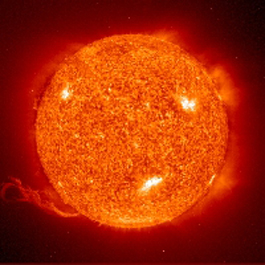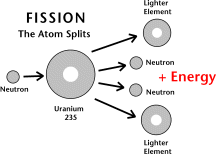
Source: NASA (Public Domain)
Did You Know?
All nuclear power in the United States is used to generate electricity.

Source: National Energy Education Development Project (Public Domain)
Nuclear Energy Is Energy in the Core of an Atom
Atoms are tiny particles that make up every object in the universe. Nuclear energy is energy in the nucleus (core) of an atom. There is enormous energy in the bonds that hold the nucleus together. Breaking those bonds releases that energy.
Nuclear energy can be used to make electricity. But first the energy must be released. It can be released from atoms in two ways: nuclear fusion and nuclear fission.
In nuclear fission, atoms are split apart to form smaller atoms, releasing energy. Nuclear power plants use this energy to produce electricity.
In nuclear fusion, energy is released when atoms are combined or fused together to form a larger atom. This is how the sun produces energy. Fusion is the subject of ongoing research, but it is not yet clear that it will ever be a commercially viable technology for electricity generation.
Nuclear Fuel — Uranium
The fuel most widely used by nuclear plants for nuclear fission is uranium. Uranium is nonrenewable, though it is a common metal found in rocks all over the world. Nuclear plants use a certain kind of uranium, referred to as U-235. This kind of uranium is used as fuel because its atoms are easily split apart. Though uranium is quite common, about 100 times more common than silver, U-235 is relatively rare.
Most U.S. uranium is mined in the Western United States. Once uranium is mined, the U-235 must be extracted and processed before it can be used as a fuel.
During nuclear fission, a small particle called a neutron hits the uranium atom and splits it, releasing a great amount of energy as heat and radiation. More neutrons are also released. These neutrons go on to bombard other uranium atoms, and the process repeats itself over and over again. This is called a chain reaction.



